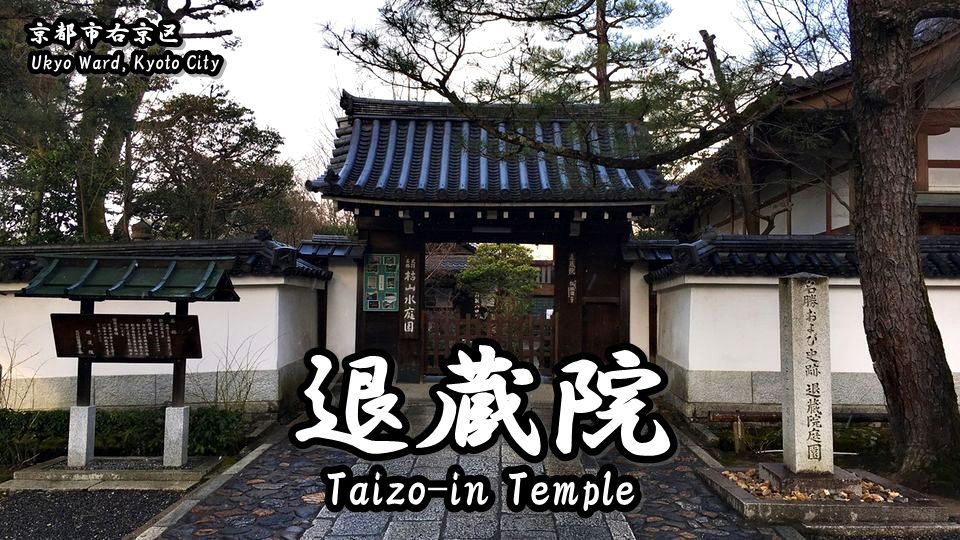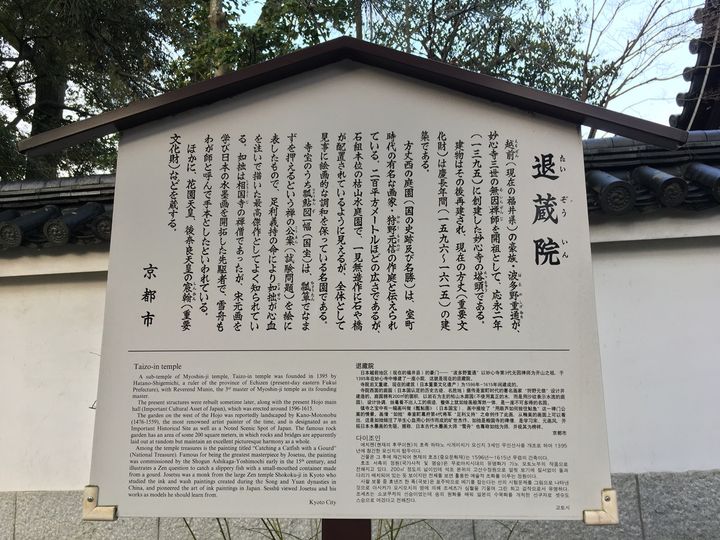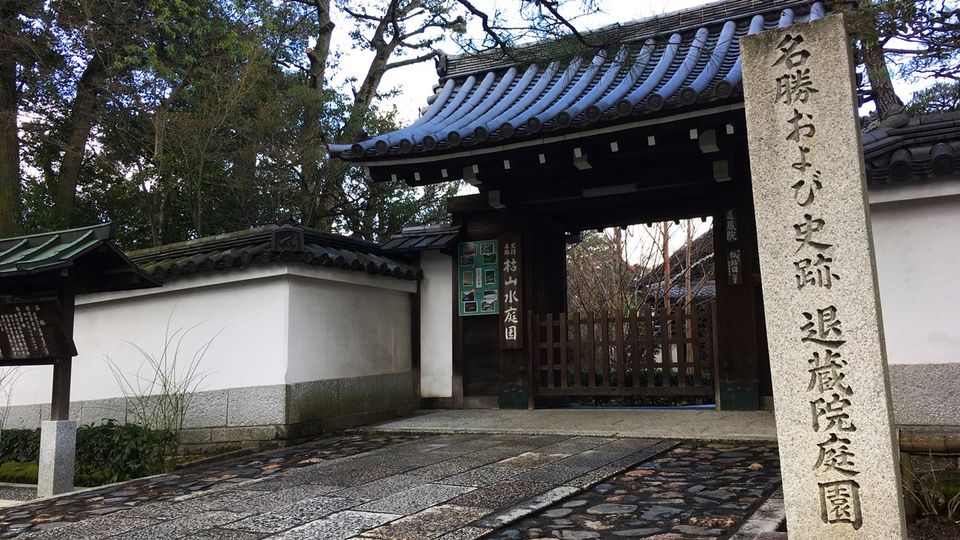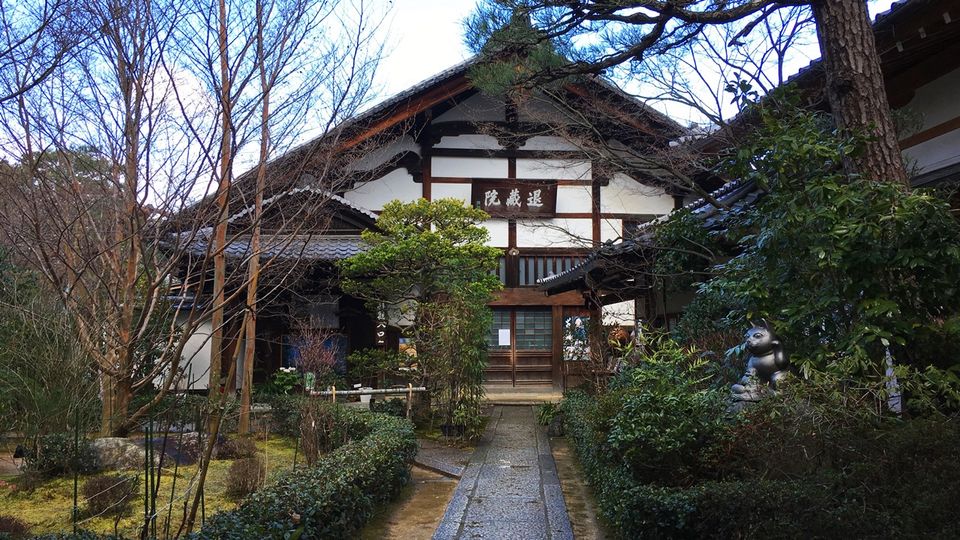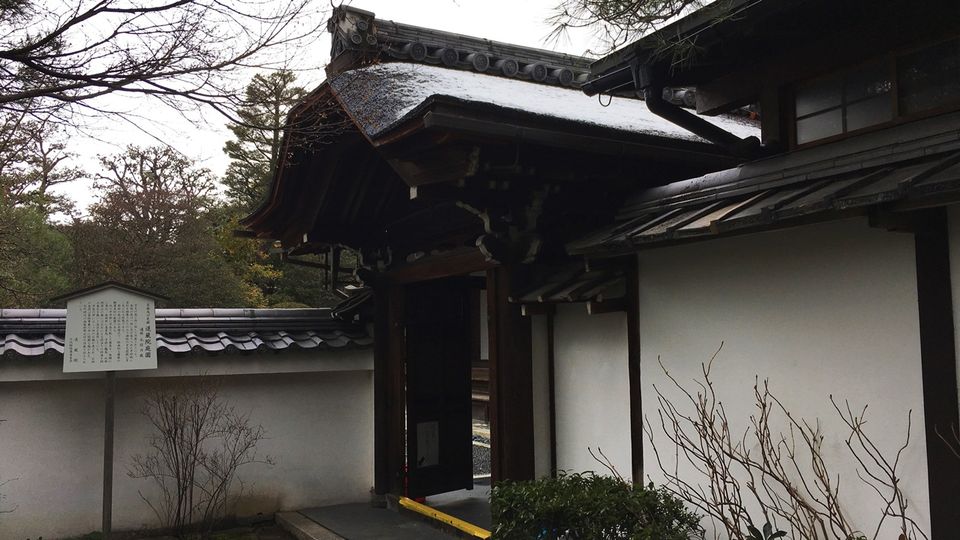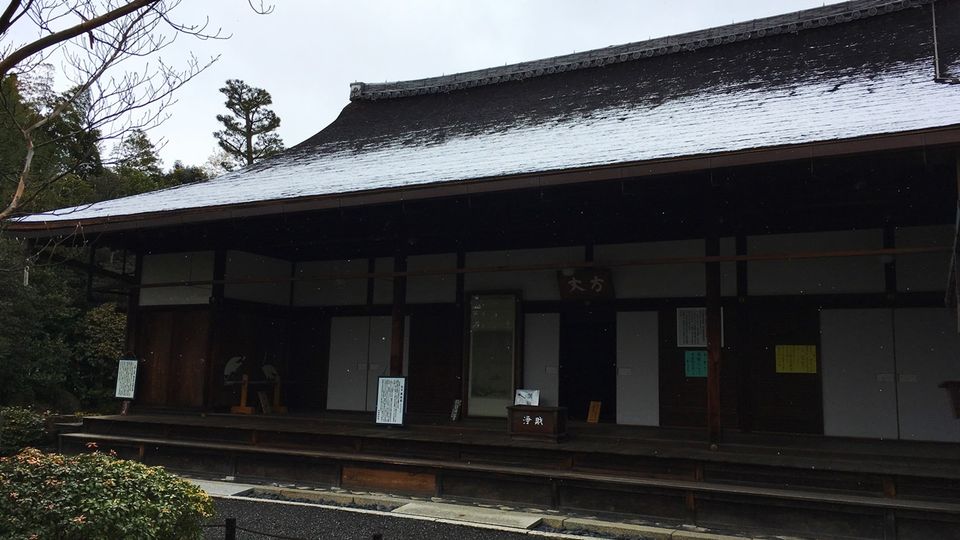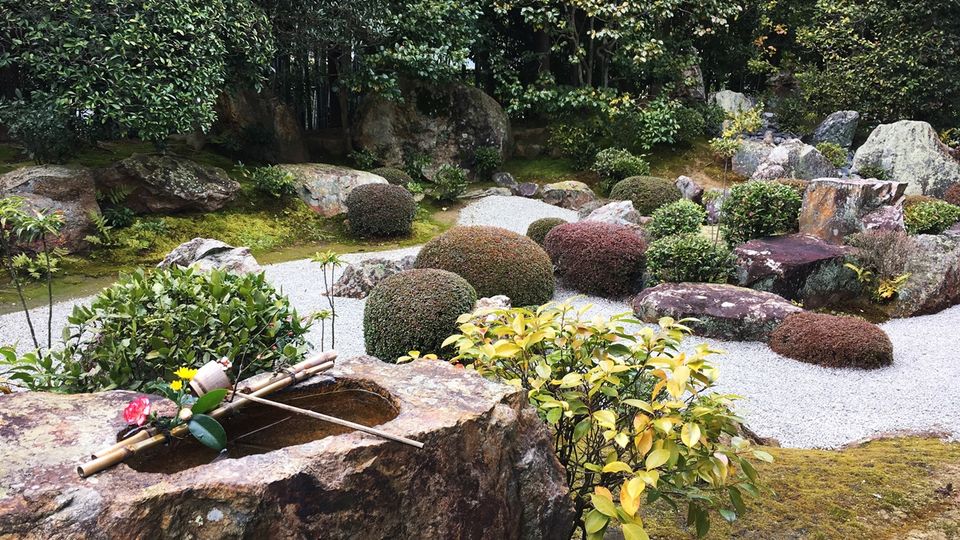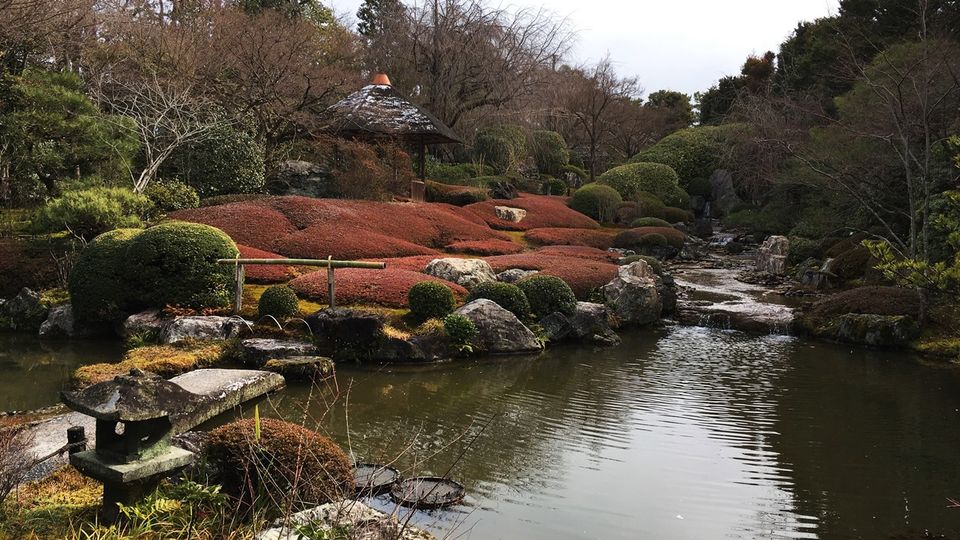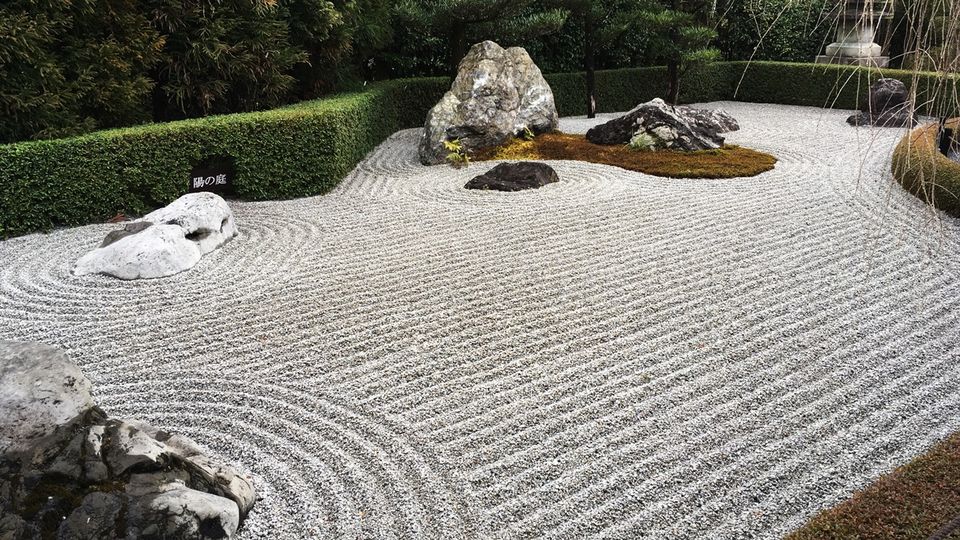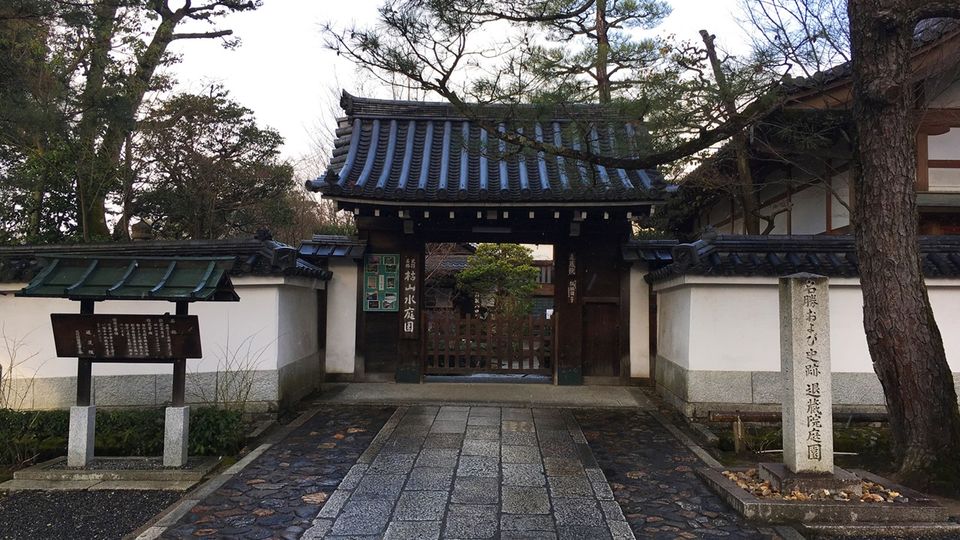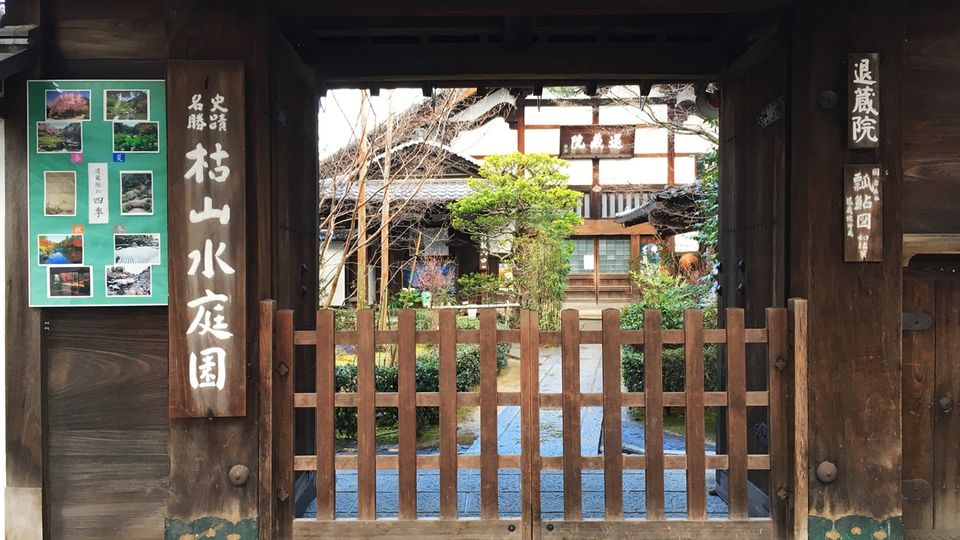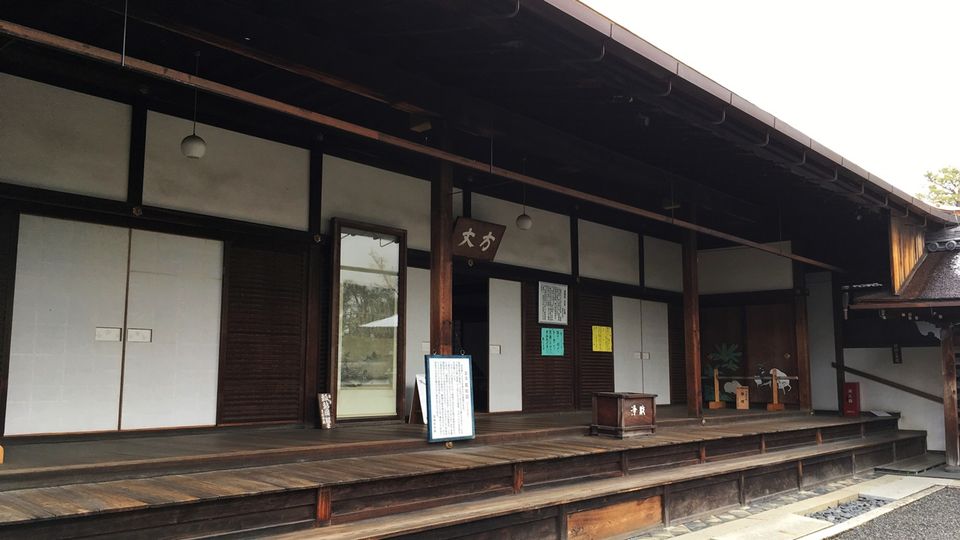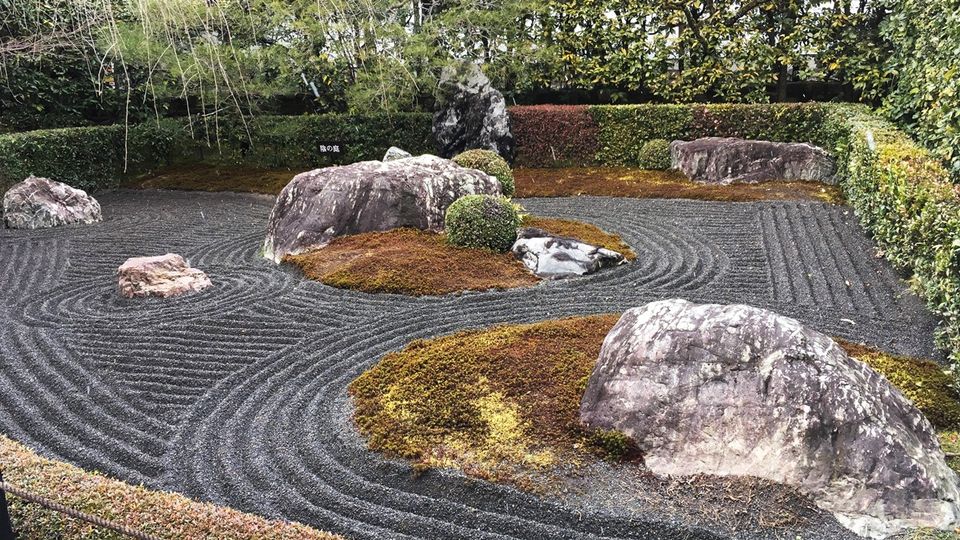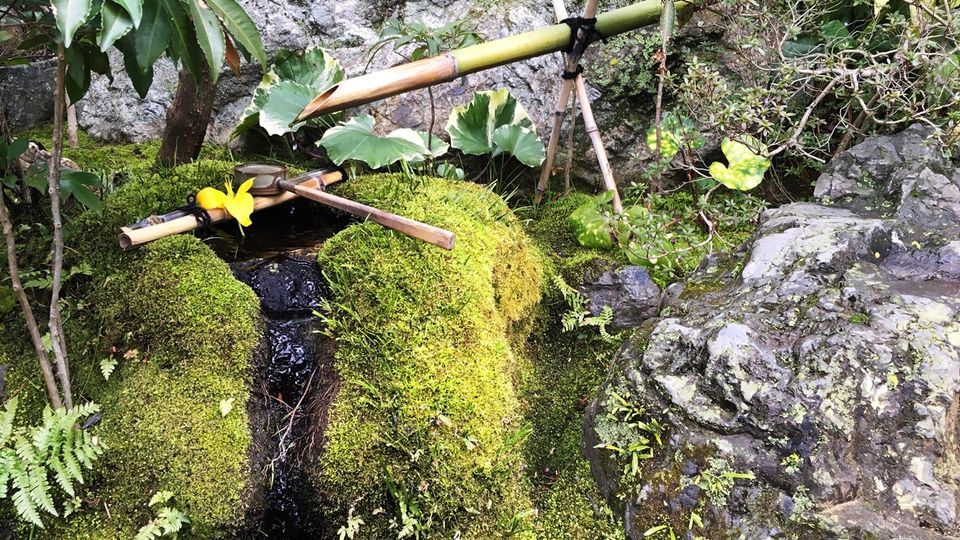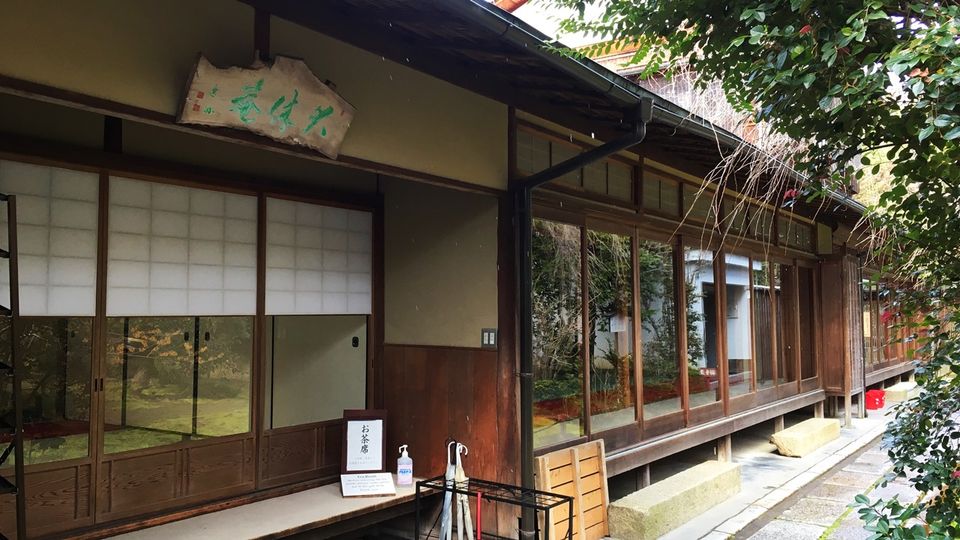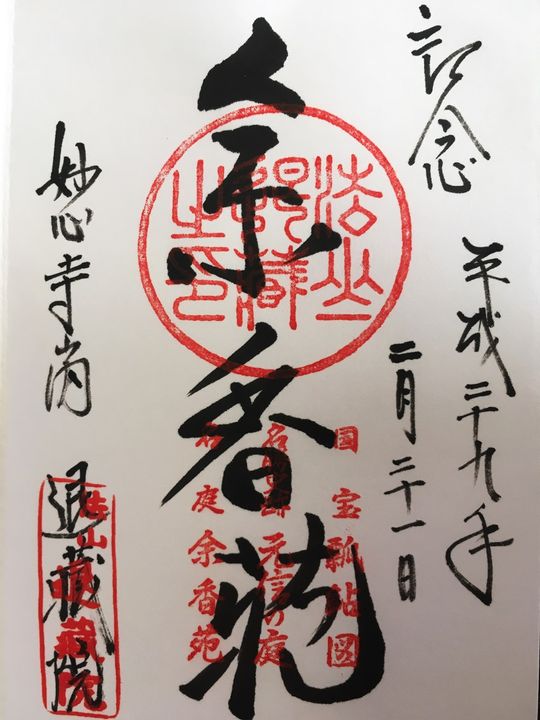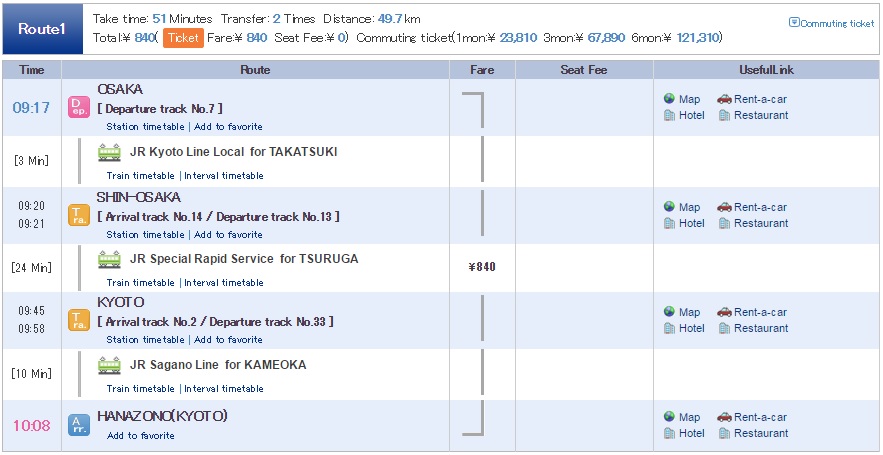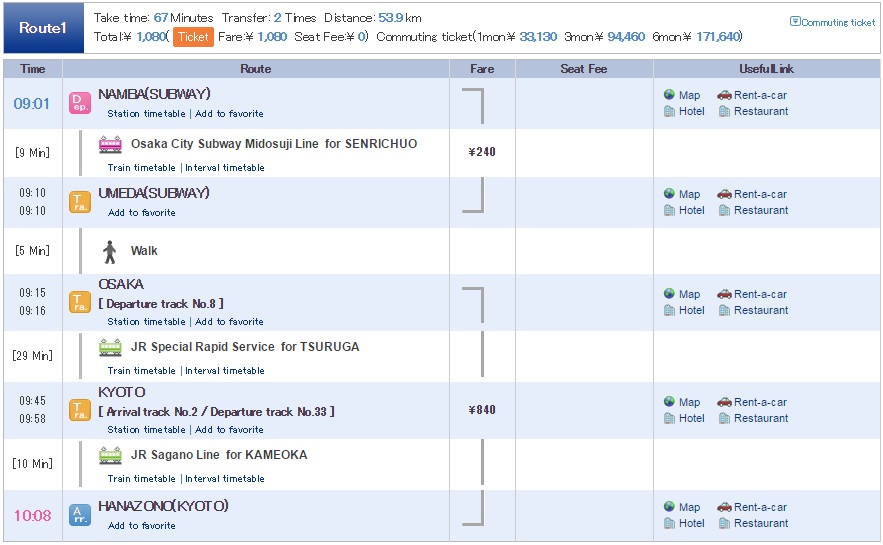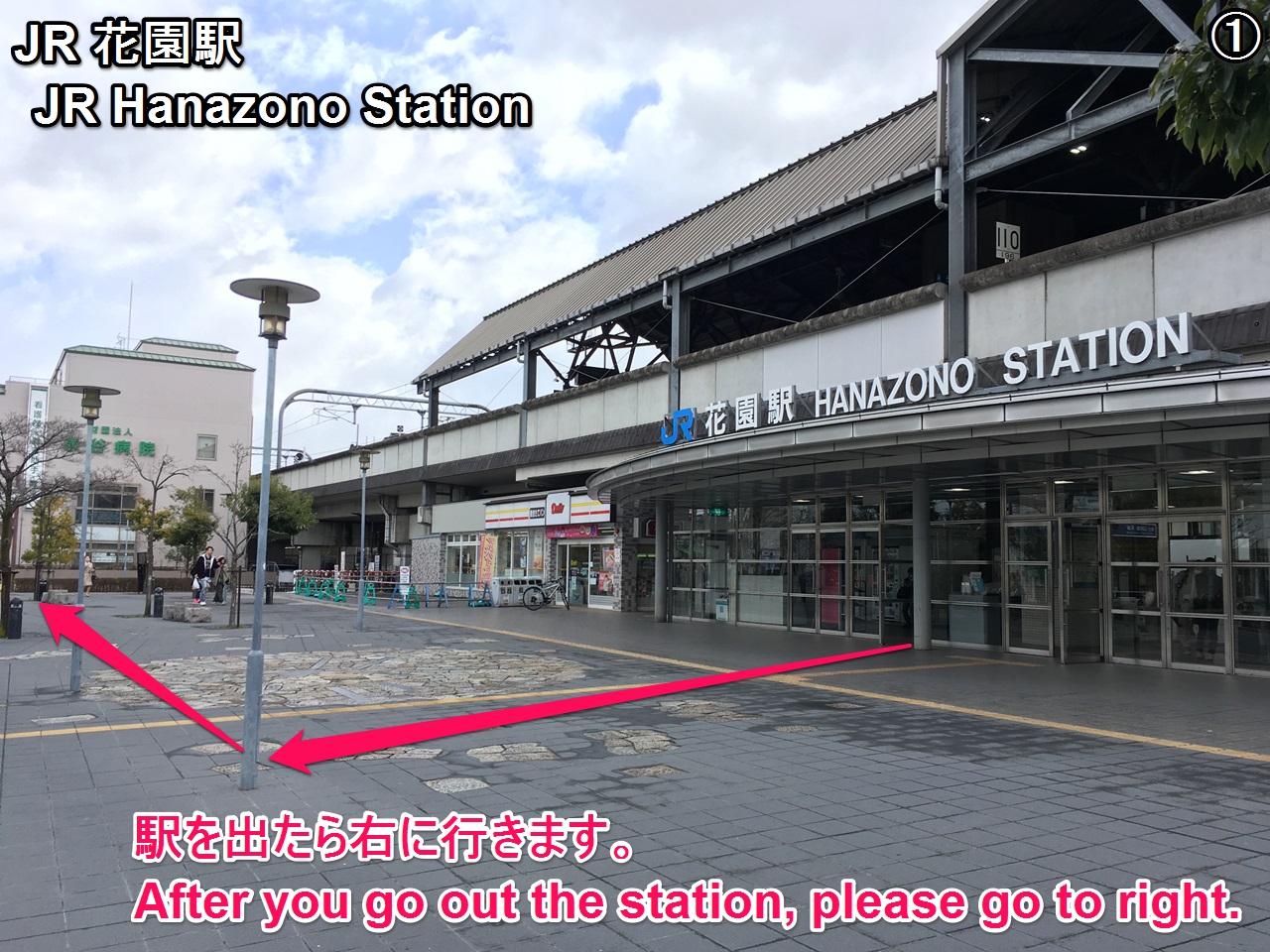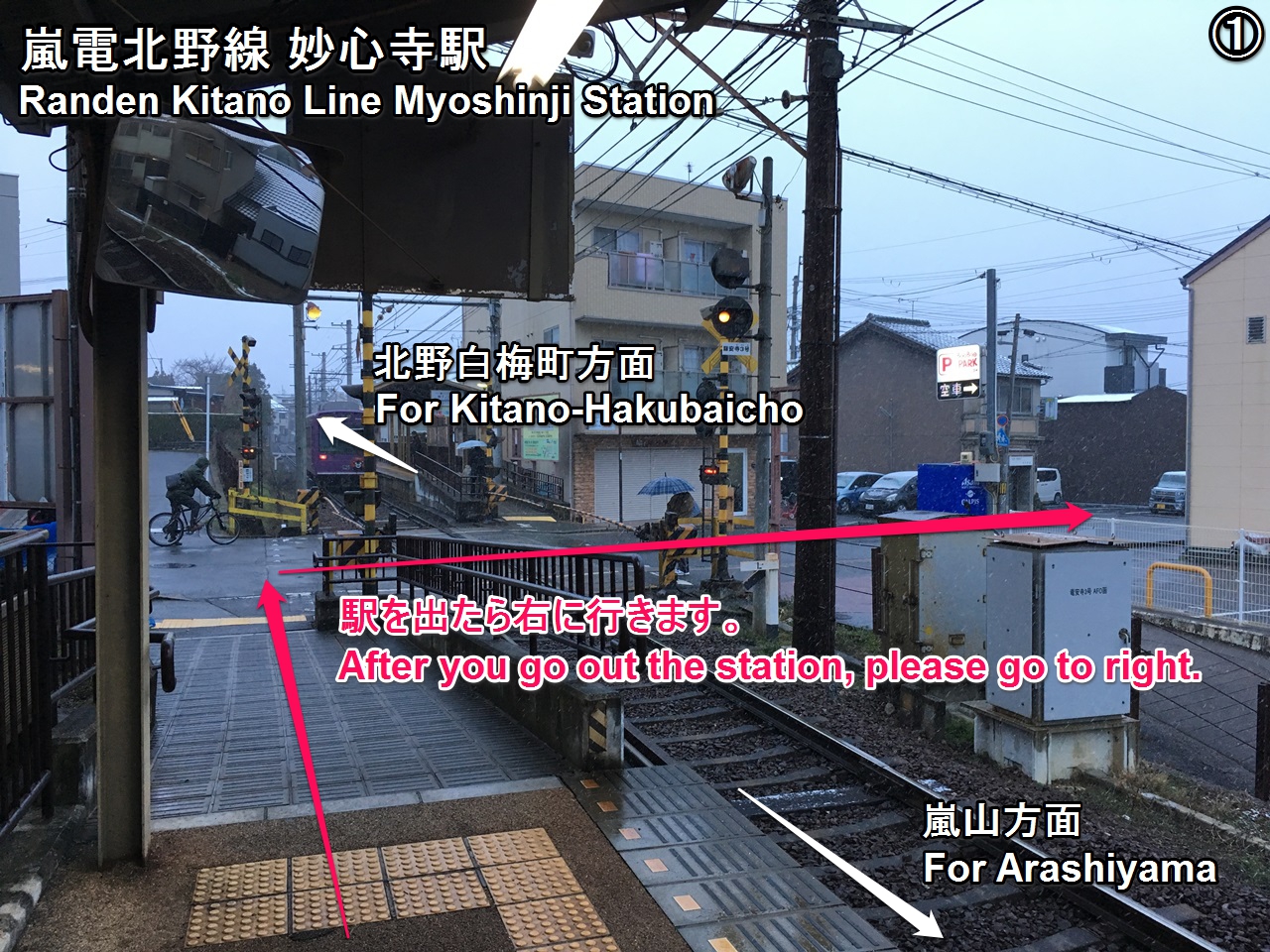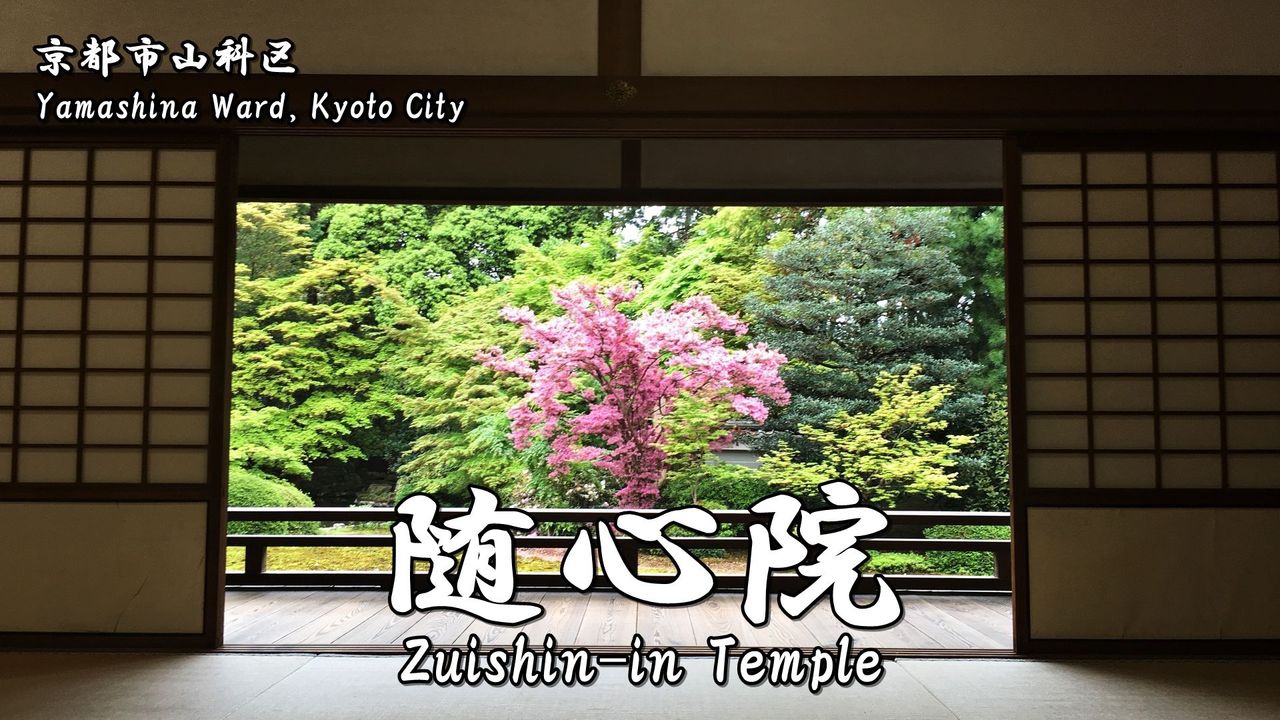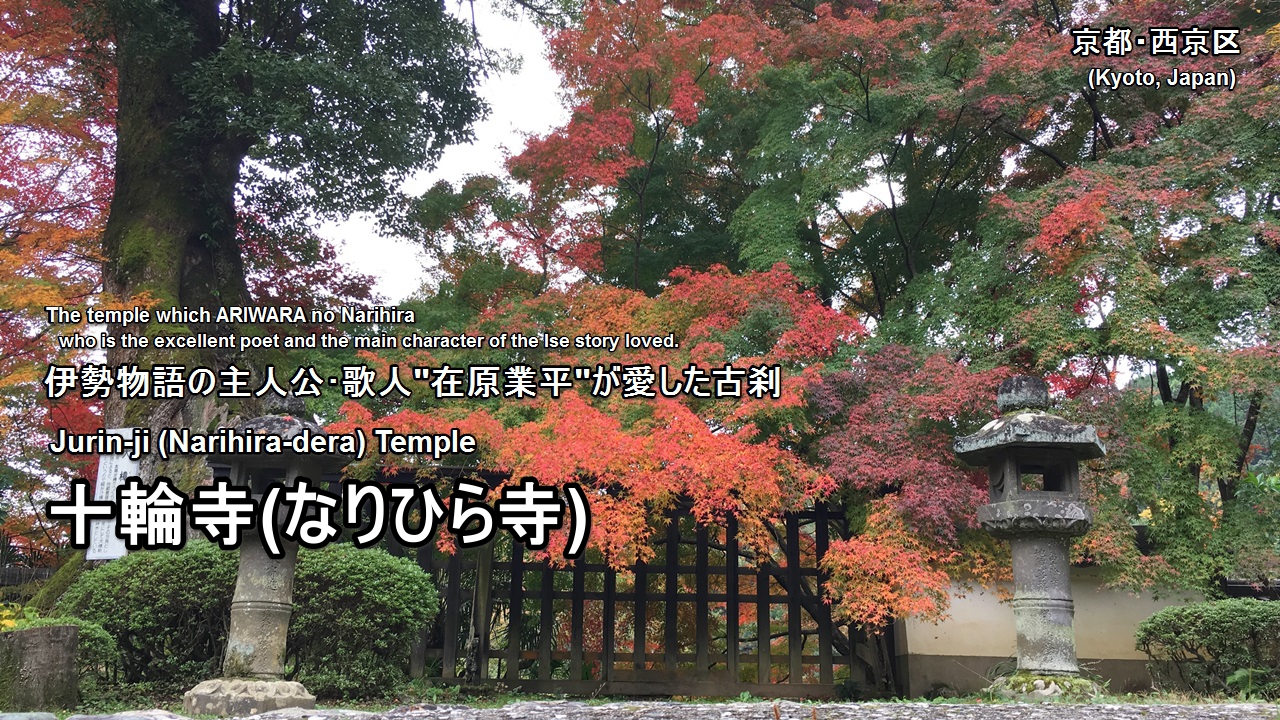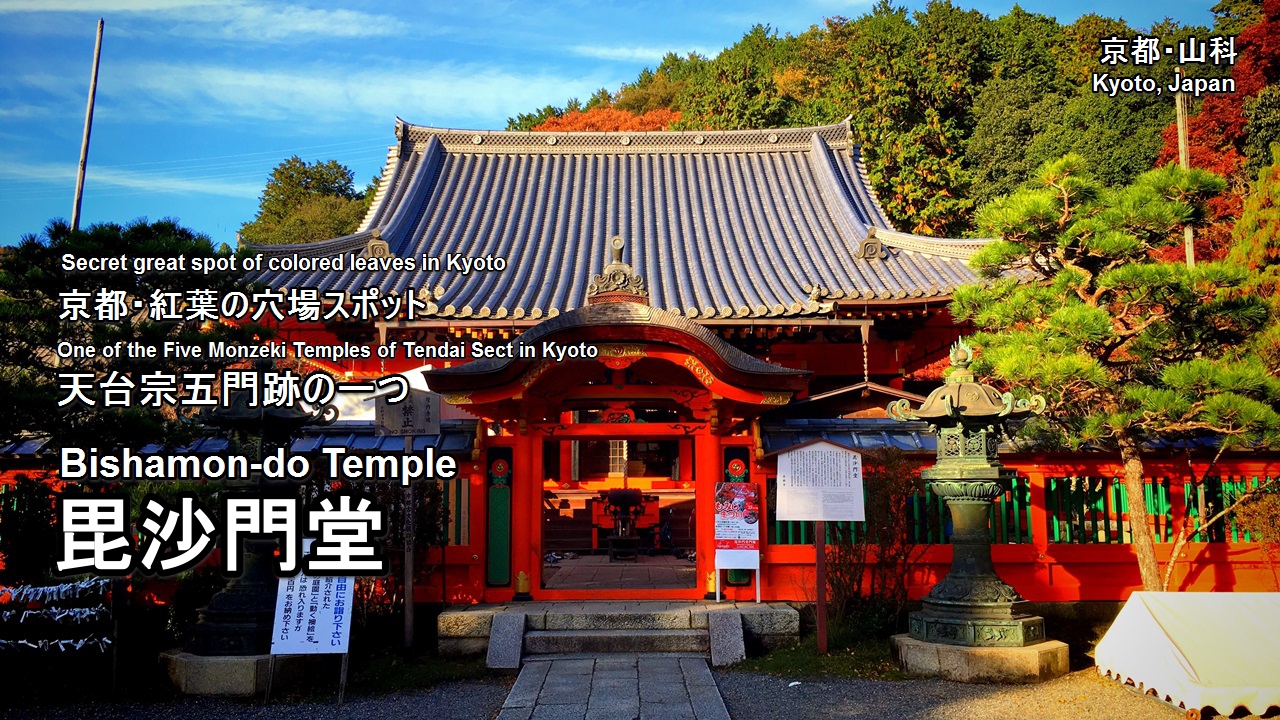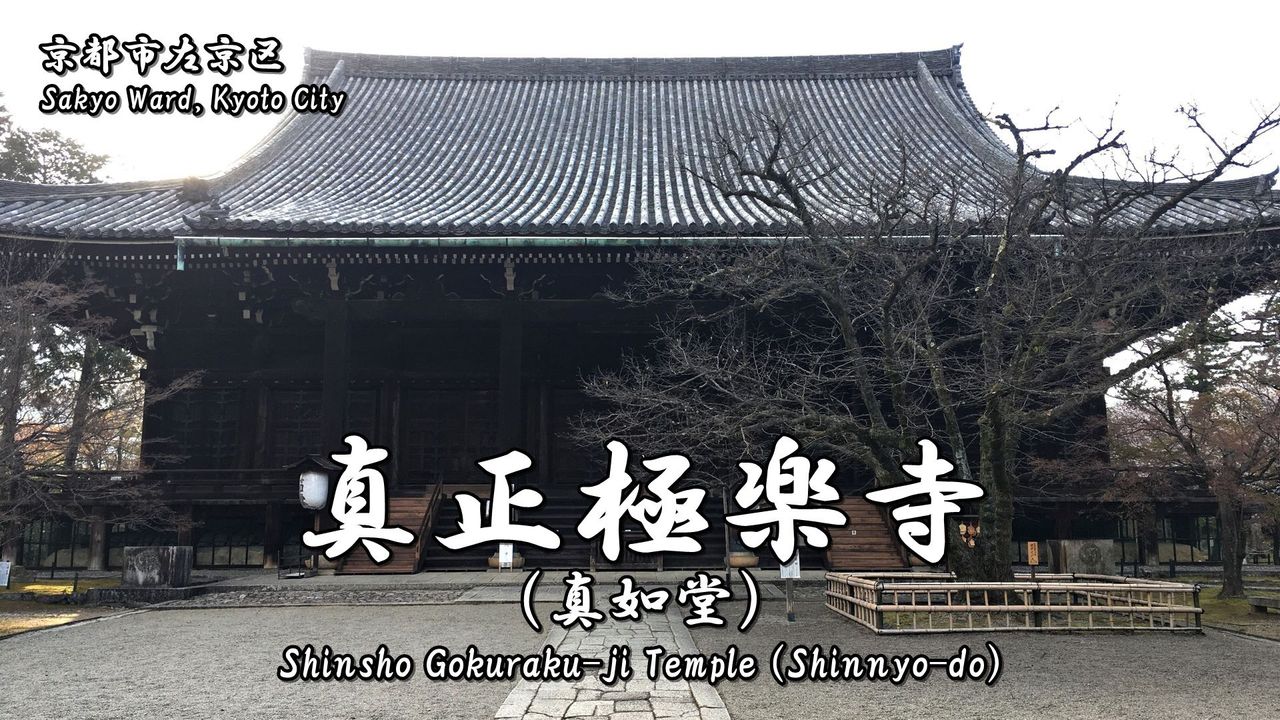Taizo-in (退蔵院) is one of the sub-temples (塔頭:tatchu) of Myoshin-ji (妙心寺) which is located in Hanazono, Ukyo Ward, Kyoto City.
Myoshin-ji is the biggest Zen temple in Japan, and it has a total of 48 sub-temples.
Taizo-in is also one of these sub-temples.
Among those sub-temples, only Keishun-in, Daishin-in, and this temple are open to the public on a regular basis.
Highlight of this temple is the ‘Hyonen-zu (Ink wash painting of catching Japanese catfish with bottle gourd)‘.
It is said to be the best masterpiece of Japanese ink wash paintings.
In addition, the garden of this temple has been designated as a historic site (史跡), a place of scenic beauty (名勝), and Michelin Green Guide ★★.
History of Taizo-in
Let’s study the history of this sub-temple with me before introducing of Taizo-in (退蔵院).
I think that we can enjoy the sightseeing of this sub-temple more by learning the history of it. XD
It was founded in 1404 by Shigemichi HATANO (波多野重通) who was a busho (a Japanese military commander) of the Echigo Province (越後国) in the Muromachi period.
When the foundation of this temple, he invited Muin Soin (無因宗因) who was the chief priest of Myoshin-ji as founding priest.
‘Taizo (退蔵)’ has the meaning of ‘the efforts behind the scenes.’
It fell into deterioration due to conflicts such as the Onin War but was restored during the Edo period.
About Taizo-in
Information
Address:35, Hanazono Myoshinjicho, Ukyo-ku Kyoto-shi, Kyoto, 616-8035, Japan
Phone number:+81-75-463-2855
Foundation:1404
Founder:Shigemichi HATANO (波多野重通)
Sect:Rinzai sect Myoshin-ji School (臨済宗妙心寺派)
Principal image:Muin Soin (無因宗因)
Open
9:00~17:00
Admission Fee
| High school students or older | 600 yen |
| Junior high and elementary students | 300 yen |
Temple’s website
Other information
・Please ask temple’s staff where you can take photos and videos.
・Worship method of a shinto shrine and a buddhist temple, please refer to the following article.

Next, Let’s go to see highlights of this temple with me!
Highlights of Taizo-in
- 山門:San-mon gate
- 庫裏:Kuri
- 大玄関 (重要文化財)*:O-genkan (Important Cultural Property)*
- 方丈 (重要文化財)*:Hojo (Important Cultural Property)*
- 瓢鮎図 (国宝)*:Hyonen-zu (National Treasure)*
- 元信の庭 (史跡・名勝)*:Motonobu’s garden (Historic Sites・Special Places of Scenic Beauty)*
- 余香苑*:Yoko-en garden*
- 陽の庭*:Yo-no-niwa garden*
- 陰の庭*:In-no-niwa garden*
- 水琴窟*:Suikinkutsu (water harp cave)*
- 大休庵(茶室)*:Daikyu-an (Tea house)*
This mark ‘*‘ is a pay area.
山門:San-mon gate
San-mon (gate) has the role as a entrance of this temple.
It has been designated as a tangible cultural properties designated by Kyoto Prefecture.
庫裏:Kuri
Kuri has the role as a priest’s living quarters or the kitchen of a temple.
A reception desk of this temple is here.
大玄関 (重要文化財)*:O-genkan (Important Cultural Property)*
O-genkan has the role as a entrance of the Hojo.
It has been designated as an important cultural property.
Because it has a shape of hakama (袴) (man’s formal divided skirt), this gate is also called ‘Hakama shaped gate‘.
方丈 (重要文化財)*:Hojo (Important Cultural Property)*
Hojo was reconstructed in 1597 of the Azuchi–Momoyama period (安土桃山時代).
It has been designated as an important cultural property.
It is said that Musashi MIYAMOTO (宮本武蔵) practiced Zen Buddhism and swordsmanship at this building in the Edo period (江戸時代).
瓢鮎図 (国宝)*:Hyonen-zu (National Treasure)*
There is a Japanese ink wash painting called ‘Hyonen-zu (瓢鮎図)‘ in this building.
This exhibiting painting is a replica now, and genuine article is deposited with Kyoto National Museum (京都国立博物館).
元信の庭 (史跡・名勝)*:Motonobu’s garden (Special Places of Scenic Beauty)*
This is the Karesansui garden (Japanese rock garden) named ‘Motonobu’s garden‘.
This garden is designed by Motonobu KANO (狩野元信) who was a painter of the Kano School (狩野派) in the Muromachi period, and have been designated as a historic site (史跡), a place of scenic beauty (名勝).
余香苑*:Yoko-en garden*
Yoko-en garden is one of the representative Japanese garden in the Showa period.
This garden was designed by Kinsaku NAKANE (中根金作) who was the most famous gardener in the Showa period.
陽の庭*:Yo-no-niwa garden*
Left side of the Yoko-en is called ‘Yo-no-niwa garden (the garden of positive)‘, covered in white sand.
陰の庭*:In-no-niwa garden*
Right side garden is called ‘In-no-niwa garden (the garden of negative)‘, covered in black sand.
‘Yo-no-niwa garden’ and ”In-no-niwa garden’ expresses a human two-facedness.
水琴窟*:Suikinkutsu (water harp cave)*
Because a sound of running water echoes in a well, it is totally like the tone of the harp.
大休庵(茶室)*:Daikyu-an (Tea house)*
Daikyu-an has the role as a tea house of this temple.
We can order a green tea (include a teacake) in this building. (500 yen)
Photos of Taizo-in
Video of Taizo-in
Goshuin (red ink stamp) of Taizo-in
Goshuin of this temple is “Yoko-en garden (余香苑)” which is the name of this temple’s garden.
We can get this goshuin in the reception desk of the entrance. (300 yen)
How to get to Taizo-in
Taizo-in is in the precincts of the Myoshin-ji.
Nearest station is JR Hanazono Station or Randen Kitano Line Myoshin-ji Station.
We can also go by bus from ‘JR Kyoto Station’, ‘Hankyu Kawaramachi Station’, and ‘Keihan Gion-Shijo Station’.
From Osaka Sta. to Hanazono Sta. (by train)
Timetable and Route Search (train)
1.Get on the JR Kyoto Line from Osaka Station to Kyoto Station and change to the JR Sagano Line.
2.Get on the JR Sagano Line from Kyoto Station to Hanazono Station.
From Namba Sta. to Hanazono Sta. (by train)
Timetable and Route Search (train)
1.Get on the Osaka Metro Midosuji-Line from Namba Station to Umeda Station and change to the JR Kyoto Line.
2.Get on the JR Kyoto Line from Osaka Station to Kyoto Station and change to the JR Sagano Line.
3.Get on the JR Sagano Line from Kyoto Station to Hanazono Station.
From Kyoto Sta. to Hanazono Sta. (by train)
Timetable and Route Search (train)
1.Get on the JR Sagano Line from Kyoto Station to Hanazono Station.
From JR Hanazono Station (on foot)
It’s about 6 minutes (400m) on foot.
From Myoshinji Station (on foot)
It’s about 5 minutes (300m) on foot.
Get on a bus from JR Kyoto Station
Timetable and Route Search (bus)
Please get on a Kyoto City Bus No.26 (Kyoto Sta.[D3]) and get off Myoshinji Kitamon-mae (Myoshinji Temple).
Bus company:Kyoto City Bus
Routes/Destination:26/Bound for Omuro Ninnaji Temple
Boarding bus stop:Kyoto Sta.[D3]
Alighting bus stop:Myoshinji Kitamon-mae (Myoshinji Temple)
Bus fare:230 yen
Get on a bus from Kyoto Kawaramachi Station
Timetable and Route Search (bus)
Please get on a Kyoto City Bus No.10 (Shijo Kawaramachi [A]) and get off Myoshinji Kitamon-mae (Myoshinji Temple).
Bus company:Kyoto City Bus
Routes/Destination:10/Bound for Kitano-tenmangu Shrine
Boarding bus stop:Shijo Kawaramachi [A]
Alighting bus stop:Myoshinji Kitamon-mae (Myoshinji Temple)
Bus fare:230 yen
Time required:About 43 min
Get on a bus from Gion-Shijo Station
Timetable and Route Search (bus)
Please get on a Kyoto City Bus No.10 (Shijo Keihan-mae [C]) and get off Myoshinji Kitamon-mae (Myoshinji Temple).
Bus company:Kyoto City Bus
Routes/Destination:10/Bound for Kitano-tenmangu Shrine
Boarding bus stop:Shijo Keihan-mae [C]
Alighting bus stop:Myoshinji Kitamon-mae (Myoshinji Temple)
Bus fare:230 yen
Time required:About 40 min
Take a taxi
From Kyoto Station:about 3,000 yen (20 minutes)
From Gion-Shijo Station:about 2,800 yen (15 minutes)
・Let’s show a taxi driver the following phrase.
・If you want to call a taxi, let’s show the following phrase.
Phone number of taxi dispatch (Kyoto Station)
Hotel search & reservation around Taizo-in
How did you like it?
Have a nice trip!

